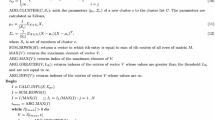Abstract
This paper proposes a probabilistic variant of the SOM-kMER (Self Organising Map-kernel-based Maximum Entropy learning Rule) model for data classification. The classifier, known as pSOM-kMER (probabilistic SOM-kMER), is able to operate in a probabilistic environment and to implement the principles of statistical decision theory in undertaking classification problems. A distinctive feature of pSOM-kMER is its ability in revealing the underlying structure of data. In addition, the Receptive Field (RF) regions generated can be used for variable kernel and non-parametric density estimation. Empirical evaluation using benchmark datasets shows that pSOM-kMER is able to achieve good performance as compared with those from a number of machine learning systems. The applicability of the proposed model as a useful data classifier is also demonstrated with a real-world medical data classification problem.
Similar content being viewed by others
Explore related subjects
Discover the latest articles, news and stories from top researchers in related subjects.References
Jain AK, Duin RPW and Mao J (2000). Statistical pattern recognition: a review. IEEE Trans Pattern Anal Mach Intell 2(1): 4–37
Duda RO, Hart PE and Stork DG (2000). Pattern classification, 2nd edn. John Wiley, New York
Duin RPW (1994). Superlearning and neural network magic. Pattern Recognit Lett 15: 215–217
Werbos PJ (1991). Links between artificial neural networks and statistical pattern recognition. In: Sethi, IK and Jain, AK (eds) Artificial neural networks and statistical pattern recognition, pp 11–31. Elsevier Science, Amsterdam
Teh CS and Lim CP (2006). Monitoring the formation of kernel-based topographic maps in a hybrid SOM-kMER model. IEEE Trans Neural Netw 17(5): 1336–1341
Devroye L, Györfi L and Lugos G (1996). A probabilistic theory of pattern recognition. Springer-Verlag, New York
Hoti F and Holmström L (2004). A semiparametric density estimation approach to pattern classification. Pattern Recognit 37(3): 409–419
Scott DW (1992) Multivariate density estimation: theory, practice and visualization. In: Probability and mathematical statistic, Wiley Series, New York
Specht DF (1988). Probabilistic neural network for classification, mapping or associative memory. Proc IEEE Int Conf Neural Netw 1: 525–532
Specht DF (1990). Probabilistic neural networks. Neural Netw 3: 109–118
Parzen E (1962). On estimation of a probability density function and mode. Ann Math Stat 33: 1065–1076
Silverman BW (1986). Density estimation for statistics and data analysis. Chapman and Hall, London
Bishop CM (1995). Neural networks for pattern recognition. Oxford University Press, Oxford
Izenman AJ (1991). Recent developments in nonparametric density estimation. J Am Stat Assoc 86: 205–224
Minnotte MC (1992) A test of mode existence with applications to multimodality. PhD Thesis, Department of Statistics, Rice University
He C and Girolami M (2003). Probability density estimation from optimally condensed data samples. IEEE Trans Pattern Anal Mach Intell 25(10): 1253–1264
Scott DW and Sheather SJ (1985). Kernel density estimation with binned data. Commun Stat Theory Methods 14: 1353–1359
Jeon B and Landgrebe DA (1994). Fast Parzen density estimation using clustering-based branch and bound. IEEE Trans Pattern Anal Mach Intell 16(9): 950–954
Holmström L and Hämäläinen A (1993). The self-organizing reduced kernel density estimator. IEEE Int Conf Neural Netw 1: 417–421
Mitra P, Murthy CA and Pal SK (2002). Density based multiscale data condensation. IEEE Trans Pattern Anal Mach Intell 24(6): 734–747
Kohonen T and Somervuo P (2002). How to make large self-organizing maps for nonvectorial data. Neural Netw 15: 945–952
Van Hulle MM (2000). Faithful representations and topographic maps: from distortion- to information-based self-organization. John Wiley, New York
Kohonen T (1988). Learning vector quantization. Neural Netw 1: 303
Yair E and Gersho A (1990). The Boltzmann perceptron network: a soft classifier. Neural Netw 3: 203–221
Lim CP and Harrison RF (1997). An incremental adaptive network for online supervised learning and probability estimation. Neural Netw 10(5): 925–939
Musavi MT, Kalantri K, Ahmed W and Chan KH (1993). A minimum error neural network (MNN). Neural Netw 6: 397–407
Breiman L, Friedman JH, Olshen RA and Stone CJ (1984). Classification and regression tree. Wadsworth, Belmont
Murphy PM and Aha DW (1995). UCI repository of machine learning databases (machine-readable data repository). Department of information and Computer Science, University of California, Irvine, CA
Carpenter GA, Grossberg S, Markuzon N, Reynolds JH and Rosen DB (1992). Fuzzy ARTMAP: a neural network architecture for incremental supervised learning of analogue multidimensional maps. IEEE Trans Neural Netw 3: 698–712
Meier F (2002, June) Liver function tests. Available: http://www.kidshealth.org/parent/
Wong OL (1996) The distribution of c-reactive protein and alpha-fetoprotein in liver disease. Master Dissertation, Faculty of Medicine, National University of Malaysia
Flores JO (2004, June) Liver function tests. Gale Encyclopedia of Medicine. Available: http://www.findarticles.com/p/articles/
Author information
Authors and Affiliations
Corresponding author
Rights and permissions
About this article
Cite this article
Teh, C.S., Lim, C.P. An Artificial Neural Network Classifier Design Based-on Variable Kernel and Non-Parametric Density Estimation. Neural Process Lett 27, 137–151 (2008). https://doi.org/10.1007/s11063-007-9065-6
Received:
Accepted:
Published:
Issue Date:
DOI: https://doi.org/10.1007/s11063-007-9065-6




